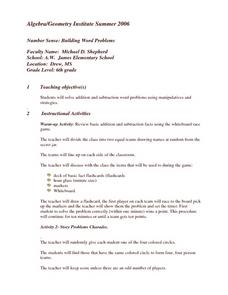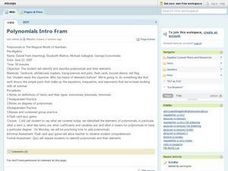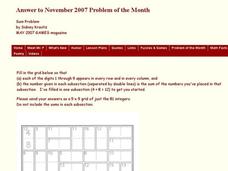Curated OER
Simplify Expression Using the Order of Operations
Allow learners to explore both the right and wrong way of completing equations with the order of operations. They discuss how the order in which operations are performed affects the outcome of a problem. A fun "trick" using order of...
Curated OER
Linear Inequalities
Ninth graders graph linear inequalities. In this Algebra I lesson, 9th graders examine the graph of a linear inequality and in a game format, test coordinates to determine the region of the graph that satisfies the inequality.
Curated OER
Diophantus II
High schoolers use an ancient math game to establish the context for solving problems by investigating them in a systematic and mathematical way. They also need to have the ability to solve various types of equations.
Alabama Learning Exchange
Battle to the Death: Adding Integers
Young scholars explore the concept of adding integers. In this adding integers lesson, students simulate the battle of the 300 spartans at Thermopylae. Young scholars use colored game pieces to represent positive and negative...
Curated OER
Mixed Factoring Review
Students solve quadratics by factoring. In this algebra lesson, students factor quadratic equations using two different methods. They solve the equations and graph using the intercepts.
Curated OER
Solving Inequalities
Seventh graders explore the concept of solving inequalities. In this inequality instructional activity, 7th graders construct inequalities for scenarios such as getting a driver's license and height requirements at a theme park. ...
Curated OER
Building Word Problems
Sixth graders study addition and subtraction facts. In equal groups, they play a race game to correctly solve addition and subtraction problems. Using a PowerPoint presentation, the teacher demonstrates how to write word problems and...
Curated OER
Quadratic Relation and Parabola
Students identify the vertex and intercepts of a parabola. In this algebra lesson, students graph parabolas and factor quadratic equations. They perform transformation on the parabolas.
Curated OER
Two Variable Inequalities
In this algebra worksheet, students solve inequalities using addition, subtractions and multiplication. They graph the inequalities with shading. There are 2 questions.
Curated OER
Polynomials in The Magical World of Numbers
Students identify and describe polynomials and their elements, discuss simple parts that make up equations, inequalities, and exponents, take notes on definitions of terms and their types, including monomials, binomials, and trinomials,...
Curated OER
PEMDAS
Sixth graders use the mneumonic device to help them remember orderof operation. In this algebra lesson, 6th graders apply PEMDAS to help them equations. They evaluate equations through PEMDAS.
Curated OER
Order of Operations
Sixth graders perform the Order of Operations. Given various story problems, groups of students solve equations requiring division, multiplication, parenthesis, exponents and other mathematical processes. They discuss the order of...
Curated OER
Guess My Rule
Students drill on math patterns, functions and Algebra. They construct and use tables to solve problems associated with mathematical relationships and identify a rule/equation. Students comprehend input/output to determine the...
Curated OER
Match The Graph Circles
High Schoolers engage in a study of circles and graphs that are related with the focus upon finding the center and radius. The lesson includes the suggestion of giving homework using circle problems before this one to create background...
Curated OER
Rational Functions
For this Algebra II/Pre-calculus worksheet, students solve and graph rational equations, identifying the intercepts and asymptotes. The six page worksheet contains nine problems. Answers are not provided.
Curated OER
Sum Problem
For this algebra worksheet, students solve linear equations by playing a sodoku like game on a 9x9 grid containing 81 integers. They find their answers through addition and summation.
Curated OER
From Probability to Combinatorics and Number Theory
Students see how division is used to help solve probability problems. They use tables as data structures where they are used to count outcomes and to compute probabilities. Students use games to help solve probability problems.
Curated OER
Addition and Subtraction in Center Time
First graders complete center activities as they practice their addition and subtraction skills. They listen to Rick Walton's, "How Many, How Many, How Many" before playing games, and completing addition and subtraction worksheets at...
Curated OER
The Lady's Age
Students use a game to establish the context of solving problems in a systematic and mathematical fashion. They also solve various types of equations to find reasonable solutions.
Curated OER
Choices
This unit is about making calculations in the real life situations of taxis, hire cars, and cell phones. They find and justify a word formula which represents a given practical situation. Solve simple linear equations such as 2? + 4 = 16.
Curated OER
Free Cell
Fourth graders use algebra to begin solving a problem. The problem has a real world application to engage learners. The main skill is converting fractions and decimals. Also finding the right number sentence for the word problem is...
Curated OER
Properties of Fractals
Students build a working definition of regular fractal, look carefully at the concepts of dimension and scale, and are introduced to logarithms. They solve simple exponential equations for the exponent both by trial and error and using...
Curated OER
Properties of Fractals
Students build a working definition of a regular fractal, they measure the concepts of dimensions and scale, they explore the concept of a logarithm and they attempt to solve simple exponential equations for the exponent both by trial...

























